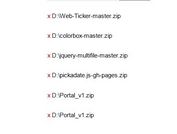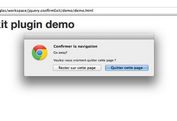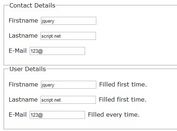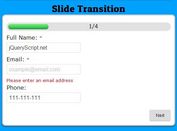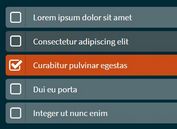Select A Date Range From A Column Chart - DateRange UI
| File Size: | 16.8 KB |
|---|---|
| Views Total: | 742 |
| Last Update: | |
| Publish Date: | |
| Official Website: | Go to website |
| License: | MIT |
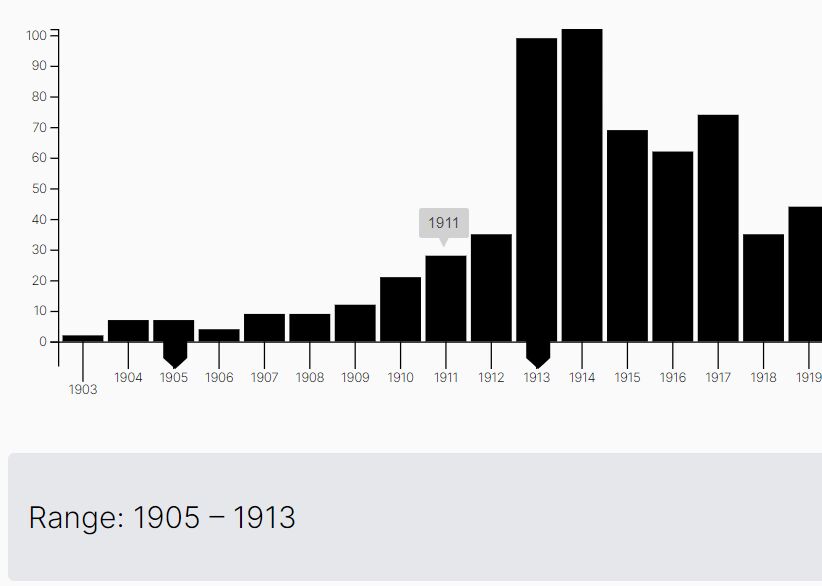
A greate alternative to a basic date range picker.
The DateRange UI jQuery plugin combines column chart and date range picker to provide a visual date selection UI.
Lightweight, animated, easy-to-use, fully responsive and touch friendly.
Built on top of jQuery and d3.js libraries.
How to use it:
1. Load the needed jQuery and d3.js libraries.
<script src="/path/to/cdn/jquery.min.js"></script> <script src="/path/to/cdn/d3.min.js"></script>
2. Load the DateRange UI's script after jQuery.
<script src="plugin.js"></script>
3. Create an empety DIV to hold the column chart & date range picker.
<div id="graph"></div>
4. Prepare your time-series data for the column chart.
var myData = [
{
// year name
"key_as_string":"1903",
// value
"doc_count":2,
// unix timestamp in milliseconds
"key":-2114384400000
},
{
"key_as_string":"1904",
"doc_count":7,
"key":-2082848400000
},
// ...
]
5. Initialize the plugin to generate a column chart along with a custom date range picker at the bottom of it.
const graph = $("#graph").daterangeselect({
data: myData,
// more options here
});
6. Available options for the DateRange UI.
const graph = $("#graph").daterangeselect({
data: myData,
height: 320,
rangeBarOpacity: 0.4,
handleScaleFactor: 1.6,
dataLengthTrigger: 30 // show tick values on x-axis for each bar or every 10th element
});
7. Override the default styles.
#graph {
position: relative;
width: 100%;
}
#range {
color: #fff;
font-size: 20px;
background-color: #d81b60;
padding: 5px 10px;
}
#graph text {
fill: #ccc;
}
#graph tik {
fill: #ccc;
}
#graph .domain, #graph line {
stroke: #ccc;
}
#graph .bars .bar {
fill: #bdb7b7;
}
#graph .bars .bar.highlight {
fill: #d81b60 !important;
}
#graph .bars .axis--x path {
display: none;
}
#graph .bars .bar.selected {
fill: #fff;
}
#graph .handles .selector {
fill: #fff;
stroke: #777;
stroke-width: 0.5px;
}
#graph .handles .selector.hovereffekt {
stroke-width: 15px;
stroke-opacity: 0.1;
stroke: #eee;
}
#graph .handles .selector.active {
fill: #ccc !important;
}
#graph .handles .range {
fill: #fff; /* #d81b60 */
stroke: none;
}
#graph .handles .selector .handlehovertext {
fill: #fff;
stroke: none;
font-size: 11px;
font-family: Helvetica, Arial;
}
#graph .empty line {
stroke: #d81b60 !important;
}
#graph .empty text {
/* fill: #d81b60 !important; */
}
8. Customize the tooltip displayed when you hover over the column chart.
#graph div.tooltip {
position: absolute;
text-align: center;
width: 40px;
height: 24px;
padding-top: 5px;
font: 12px sans-serif;
background: #ccc;
border: 0px;
border-radius: 2px;
pointer-events: none;
color: #333;
}
#graph div.tooltip:after {
box-sizing: border-box;
display: inline;
width: 100%;
line-height: 1;
color: #ccc;
content: "\25BC";
position: absolute;
text-align: center;
margin: -3px 0 0 0;
top: 100%;
left: 0;
}
9. Callback functions.
const graph = $("#graph").daterangeselect({
data: myData,
onRangeUpdate: function (obj) {
//var myJSON = JSON.stringify(obj);
//console.log("Clicked Section Data",obj);
},
hoverText: function (obj) {
return obj.key_as_string;
}
});
10. Update the column chart.
$("#graph").daterangeselect("update", newData);
This awesome jQuery plugin is developed by jpweinerdev. For more Advanced Usages, please check the demo page or visit the official website.
